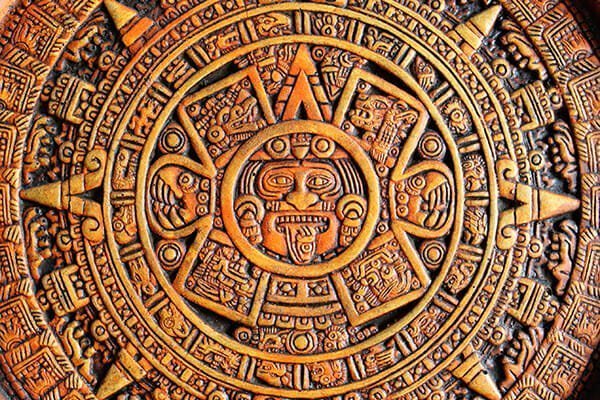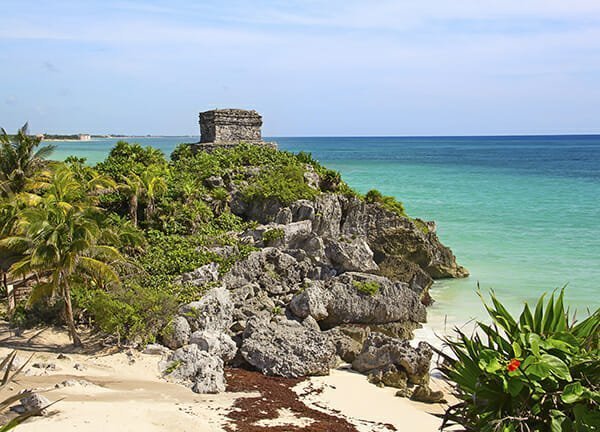
Mayan Ruins of the Yucatan Peninsula
Mayan Ruins of the Yucatan Peninsula
Not everything on the Yucatan Peninsula revolves around white sand beaches, endless sun, partying, and the world-class amenities of huge resorts and hotels.
by William Burr
The region in and around the Riviera Maya also has some of the best Mayan ruins to be found anywhere in Mexico. From Cancun in the north, a modern highway follows the coast all the way to Sian Ka’an and the endpoint of the developed areas. Mile after mile, visitors travel past resorts, hotels, condos, homes, and villages large and small. But the jungle hides the area’s brightest treasures. Other than the ruins at Tulum that overlook the sea, most of the Mayan ruins are deep in the jungle; some are close, while others are up to a five-hour drive inland. But every mile is worth the experience. Modern highways go arrow-straight through seemingly endless jungle before coming to one of these historic Mayan excavations. Though most of the known sites have been worked on for years by archeologists, only a small percentage of each site has been restored. When a visitor stands on the upper reaches of a temple or pyramid and looks out over the jungle stretching flat and green as far as the eye can see, huge mounds can be seen covered by jungle growth, the location of unearthed treasures yet to be excavated. It takes only a little imagination to recreate the glory and magnificence of these timeless cities of the extraordinary Mayan culture.
Coba Mayan Ruins
This ancient site is about two-and-a-half hours from Cancun and is different from the other big archaeological sites in the Yucatan by being situated near four natural lakes, a rare experience in the Yucatan. These lakes are believed to have given Coba its name, which means “waters stirred by wind.” Not as thoroughly excavated or reconstructed as Chichen Itza or Tulum, Coba has a nearly uncountable number of structures that remain covered with jungle growth, making it a wild place that is unlike anything else. With fewer tourists than Chichen Itza or Tulum, a visitor might find himself alone on a wandering trail in dense jungle with only birds and monkeys to accompany him through the mystical ruins.
Archaeologists are convinced that Coba will prove to be one of the largest Mayan excavations on the Yucatan Peninsula, given that more than 5,000 mounds are yet to be uncovered.
Chichen Itza Mayan Ruins
Chichen Itza is probably the most important city of the Mayan culture near the Riviera Maya and has some unusual buildings compared to other ancient Mayan cities. As one of the largest and most impressive of the Mayan ruins, it covers an area of approximately six square miles where hundreds of buildings once stood. Most are still mounds covered by jungle growth, but more than thirty can be seen by tourists.
Built between the 7th and 10th centuries A.D., the city became a prominent ceremonial center until a second group of buildings was constructed during the 10th to the 13th centuries A.D. This later period includes the Sacred Well and most of the outstanding ruins visible today.
Possibly the best known of these is El Castillo, a square-based, stepped pyramid that is approximately 75 feet tall. Built for astronomical purposes, it demonstrates the extraordinary mathematical science of the Mayans during the annual vernal equinox. At about 3 p.m., sunlight bathes the pyramid’s main stairway causing seven isosceles triangles to form that imitate the body of a serpent 37 yards long. As the minutes tick by, the serpent creeps downward until it joins a huge snake’s head carved in stone at the bottom of the stairway.
Tulum Mayan Ruins
The Tulum ruins, located a few hours’ drive south of Cancun, are considered by many as the most beautiful of the Mayan ruins. The site is small but exquisitely poised on 50 foot-high cliffs above the blue waters of the Caribbean. Visitors can roam the watchtower and temple that are literally hanging on top of the cliff. In the Mayan language, Tulum means “wall” because it was once a walled city, one of the few the ancients ever built.
Other Mayan Ruins
 Though the three sites listed above are the ones most often visited from the Riviera Maya, there are literally dozens of others, some large, some small, each with an exotic name. They include:
Though the three sites listed above are the ones most often visited from the Riviera Maya, there are literally dozens of others, some large, some small, each with an exotic name. They include:
— Ek Balam, an ancient Mayan city with an amazing acropolis filled with paintings and calligraphy
— Ik Kill, which features a huge Cenote or sinkhole 85 feet down with clear, deep water where visitors may swim
— Sian Ka’an, located near Tulum, a UNESCO World Heritage site, plus an enormous biosphere
–Uxmal, located hours away on the far side of the Yucatan peninsula, but worth the visit as one of the most extensive sites in all of Mexico.
Travel in and around the Yucatan Peninsula
The Riviera Maya is unique and filled with expats and visitors from all over the world. The area enjoys a stable Mexican government, is a destination close to the U.S., and has an inexhaustible supply of condos and houses to rent or to buy for a steady income, even to use as a vacation residence. All the comforts of home make this area of Mexico safe and reliable when traveling from the international airport at Cancun along first-class highways with modern gas stations and past villages catering to tourists. It’s a journey during which you can enjoy the rare experience of being at ease and familiar in a Latin American country.
The Temazcal Experience
Part of the ancient Mayan experience is alive and well at the TAO Wellness Community near Akumal on the coast. The Wellness Center is a sanctuary for health, relaxation, and a soothing of the body, mind, and spirit in a community that stresses fitness and living well. The facility includes a fully equipped gym, a yoga classroom, a salt-water lap pool, an infinity pool, massage and spa rooms, an elixir bar, meditation areas, a steam room, and a store filled with health-supporting gifts. All of this, plus the Temazcal Mayan ritual experience, gives the seeker of a healthy lifestyle a full plate of options. But the Temazcal ritual is one you will rarely find anywhere else and is an event not to be missed.
Efran, an authentic Mayan shaman, holds court over the traditional Temazcal ceremony, which is akin to that of a more conventional hot room, or similar to a North American Indian sweat lodge. The ceremony is meant to purify and re-energize the body and usually has a lasting influence. Offered at dusk, the treatment weaves together ancient traditions, chants, and meditation. The recipient is given a piece of Copal (a tree resin that is lit and burned like incense) and then asked to pray in his or her own version of religion. On entering the sweat lodge, a participant finds a mound of red-hot stones until the door closes and the room becomes pitch-black. The shaman chants and adds water to the rocks, which makes the room extremely hot and humid. The session often lasts up to two hours as the shaman chants and adds water to the rocks creating intense heat. The experience gives an almost ethereal sensation of floating in a timeless ocean of darkness, sound, and aromatic mist. Many who have gone through this ancient Mayan tradition have remarked that they left the Temazcal feeling relaxed, lighter in spirit, and emotionally cleansed. Remarkably, the physical challenge of intense heat seems to overcome many obstacles a person faces and stimulates a healthy state of mind in those who participate.
Previously published in the 2016 Spring Issue.
Receive your complimentary Relocation guide and magazine



